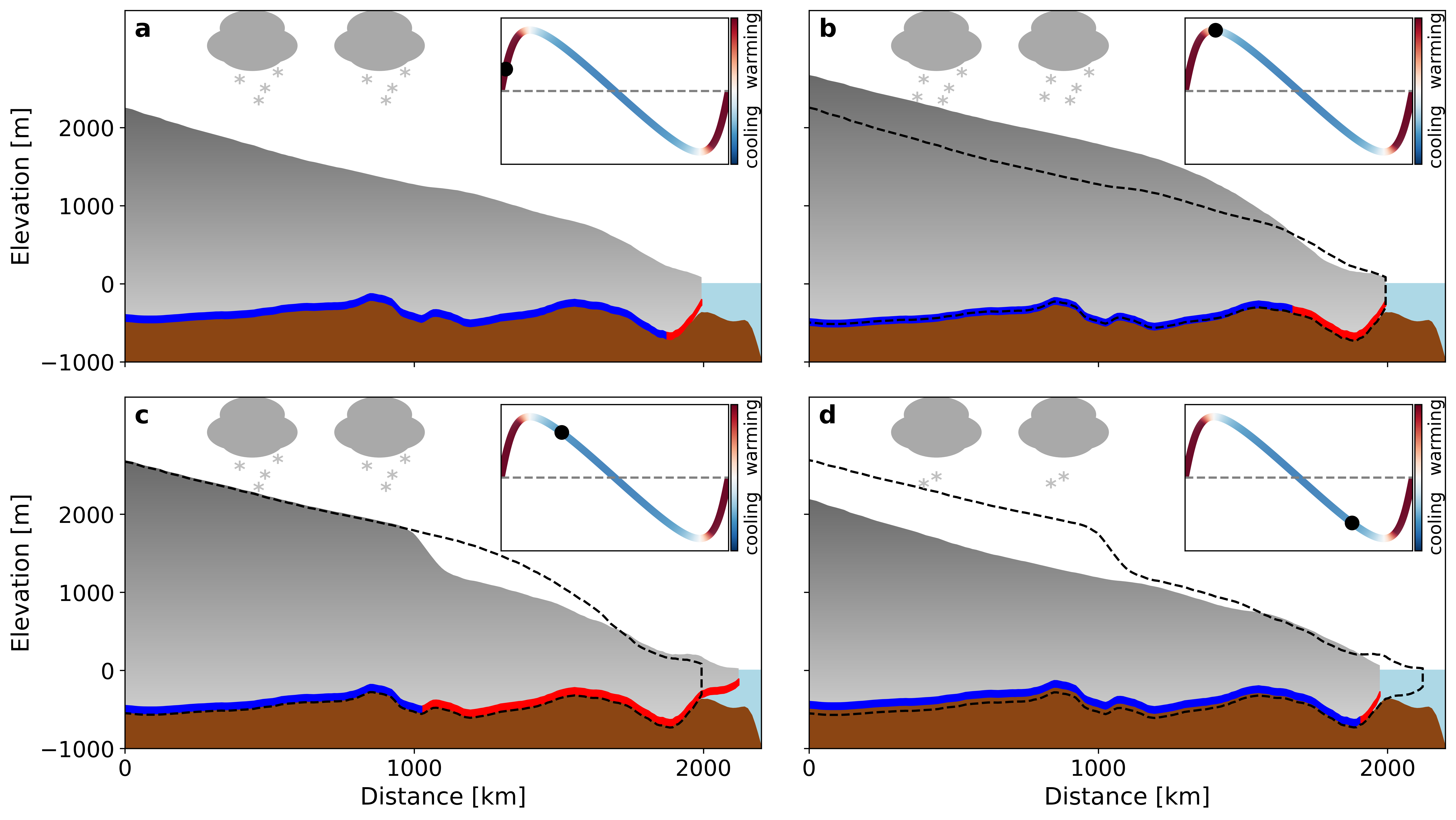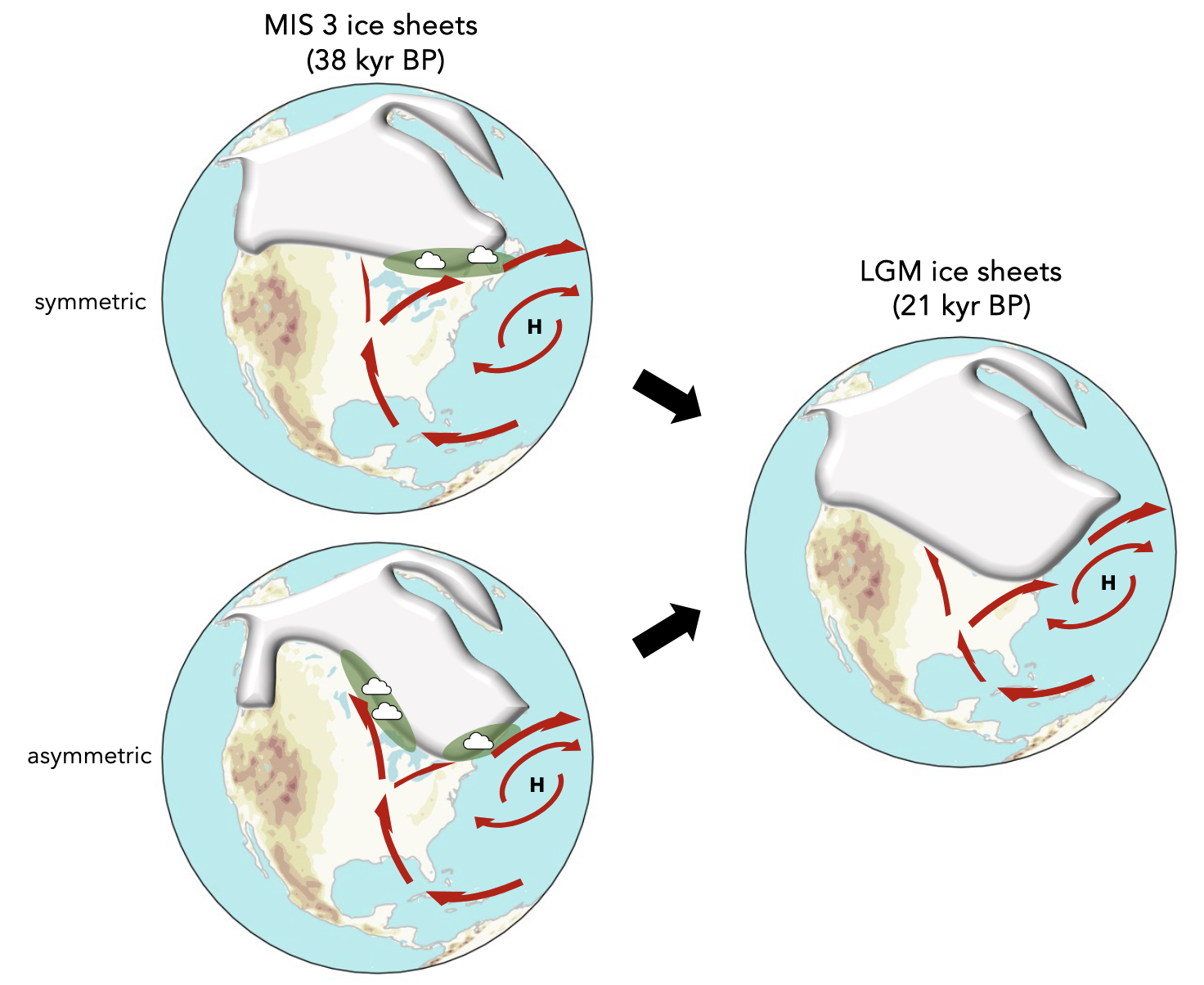SAVE THE DATE
We will hold our next General Assembly for all PalMod Members on
Mon. 16.6. and Tue. 17.6.2025 @ MARUM in Bremen.
This is the link to the registration page.
Here you find the preliminary version of the agenda.
PalMod (and PalMod related) presentations @ EGU2025, 27.4 - 2.5.25, Vienna
PalMod Papers from 2025:
Duque-Villegas, M., Claussen, M., Kleinen, T., Bader, J. & Reick, C. (2025). Pattern scaling of simulated vegetation change in North Africa during glacial cycles. Climate of the Past, 21(4), 773-794, https://cp.copernicus.org/articles/21/773/2025/
Song, P., Scholz, P., Knorr, G. et al. Regional conditions determine thresholds of accelerated Antarctic basal melt in climate projection. Nat. Clim. Chang. (2025). https://doi.org/10.1038/s41558-025-02306-0
Adam, M., Kleinen, T., May, M. & Rehfeld, K. (2025). Land conversions not climate
effects are the dominant consequence of sun-driven CO2 capture, conversion and
sequestration. Environmental Research Letters, 20: 034011. doi:10.1088/1748-9326/ada971
Braschoss, L., Weitzel, N., Baudouin, J.-P., and Rehfeld, K.: State-dependency of dynamic and thermodynamic contributions to effective precipitation changes, Journal of Climate, 38, 731-748, doi.org/10.1175/JCLI-D-24-0355.1, 2025.
Rietkerk, M., Skiba, V., Weinans, E., Hébert, R., Laepple, T.: Ambiguity of early warning signals for climate tipping points. Nat. Clim. Chang. (2025). https://doi.org/10.1038/s41558-025-02328-8
Mikolajewicz, U., Kapsch, M.-L., et al., 2025: Deglaciation and abrupt events in a coupled comprehensive atmosphere–ocean–ice-sheet–solid-earth model, Clim. Past, 21, 719–751, https://doi.org/10.5194/cp-21-719-2025.
Andernach, M., Kapsch, M.-L., and Mikolajewicz, U., 2025: Impact of Greenland Ice Sheet disintegration on atmosphere and ocean disentangled, Earth Syst. Dynam., 16, 451–474, https://doi.org/10.5194/esd-16-451-2025.
Ziegler, E., Weitzel, N., Baudouin, J.-P., Kapsch, M.-L., et al., 2025: Patterns of changing surface climate variability from the Last Glacial Maximum to present in transient model simulations, Clim. Past, 21, 627–659, https://doi.org/10.5194/cp-21-627-2025.
Baudouin, J.-P., Weitzel, N., May, M., Jonkers, L., Dolman, A. M., and Rehfeld, K.: Testing the reliability of global surface temperature reconstructions of the Last Glacial Cycle with pseudo-proxy experiments, Clim. Past, 21, 381–403, https://doi.org/10.5194/cp-21-381-2025, 2025.
Niu, L., Knorr, G., Ackermann, L., Krebs-Kanzow, U., Lohmann, G.: Eurasian ice sheet formation promoted by weak AMOC following MIS 3. npj Clim Atmos Sci 8, 85 (2025). https://doi.org/10.1038/s41612-025-00982-5
Schild, L., Ewald P., Li C., Hébert R., Laepple, T. & Herzschuh, U.: „LegacyVegetation: Northern Hemisphere reconstruction of past plant cover and total tree cover cover from pollen archives of the last 14 ka“. Earth System Science Data, 2025, https://doi.org/10.5194/essd-2023-486.
Trombini, I., Weitzel, N., Valdes, P. J., Baudouin, J.-P., Armstrong, E., and Rehfeld, K.: Atmospheric and Oceanic Pathways Drive Separate Modes of Southern Hemisphere Climate in Simulations of Spontaneous Dansgaard-Oeschger-Type Oscillations, Geophysical Research Letters, 52, e2024GL111473, doi.org/10.1029/2024GL111473, 2025.
Zhang, Z., Poulter, B., Melton, J., Riley, W., Allen, G., Beerling, D., Bousquet, P., Canadell, J., Fluet-Chouinard, E., Ciais, P., Gedney, N., Hopcroft, P., Ito, A., Jackson, R., Jain, A., Jensen, K., Joos, F., Kleinen, T., Knox, S., Li, T., Li, X., Liu, X., McDonald, K., McNicol, G., Miller, P., Müller, J., Patra, P., Peng, C., Peng, S., Qin, Z., Riggs, R., Saunois, M., Sun, Q., Tian, H., Xu, X., Yao, Y., Xi, Y., Zhang, W., Zhu, Q., Zhu, Q. & Zhuang, Q. (2025). Ensemble estimates of global wetland methane emissions over 2000-2020. Biogeosciences, 22(1), 305-321. doi:10.5194/bg-22-305-2025.
New PalMod Highlight Paper
A new mechanism for synchronising Heinrich events with Dansgaard-Oeschger cycles
The northern hemispheric climate during the last glacial period (ca. 65,000-15,000 years before present) was dominated by two prominent signals of glacial climate variability, known as Dansgaard-Oeschger cycles and Heinrich events. The episodic Heinrich events, defined by an enhanced ice discharge from the Laurentide ice sheet, tend to coincide with cold phases of the Dansgaard-Oeschger cycles, which are periodic and abrupt warming and cooling cycles. This suggests a tight connection, but the exact mechanisms remain enigmatic to this day. In their recent study, Schannwell et al. introduce a new mechanism that explains how Heinrich events are synchronised with Dansgaard-Oeschger cycles.
Using simulations with a coupled ice sheet-solid earth model that are forced with a synthetic Dansgaard-Oescher cycle, Schannwell et al. present a Heinrich event mechanism that overcomes previous shortcomings and reproduces all main characteristics of Heinrich events from the paleo record under a wide range of forcing scenarios. In their mechanism, internal ice-sheet instabilities are the underlying cause for triggering Heinrich events. The timing of these events, however, can be locked into the cooling phase of the Dansgaard-Oeschger cycle through an atmospheric perturbation (e.g. snowfall and surface temperature) that is induced by the Dansgaard-Oeschger cycle itself. The atmospheric mechanism permits a pan-ice sheet response and allows for the occurrence of synchronous Heinrich events from two ice streams of the Laurentide ice sheet – a characteristic from the paleo record that previous theories revolving around the ocean as the key driver have so far failed to explain.
A distinct advantage of the atmospherically driven mechanism is that it is applicable to both, ice streams terminating in the ocean as well as ice streams terminating on land. Therefore, the mechanism could provide insights not only on episodic glacier accelerations in the past, such as Heinrich events, but also on modern-day episodic accelerations observed from mountain glaciers and ice streams draining the Greenland and Antarctic ice sheets.

Figure: Phases of the Heinrich event. (a) Intensified build-up phase of the ice stream during the interstadial period. (b) The ice stream reaches the critical ice thickness and temperature threshold for a Heinrich event during the interstadial period. (c) Onset of the Heinrich event during the late interstadial period. (d) Decay of the Heinrich event at the end of the stadial. The dashed outline shows the position of the previous snapshot. The red colour at the bottom of the ice stream shows regions where the ice is at the pressure melting point, while the blue colour shows regions where the ice is frozen to the ground. The insets show the approximate time of the current snapshot within the Dansgaard-Oeschger cycle
Orginal publication:
Schannwell, C., Mikolajewicz, U., Kapsch, M.-L., Ziemen, F. (2024). A mechanism for reconciling the synchronisation of Heinrich events and Dansgaard-Oeschger cycles. Nature Communications 15, 2961, https://doi.org/10.1038/s41467-024-47141-7
------
Rapid growth of land ice due to summer snowfall
During the Last Glacial Maximum (LGM, ~21,000 years ago), the Laurentide ice sheet covered large parts of North America – reaching an ice thickness of more than 3 km, before it finally melted at the end of the ice age. To date, there have been few detailed studies of the evolution of the North American ice sheet into the LGM. In a new study published in the journal Nature Geoscience, researchers from the Alfred Wegener Institute, Helmholtz Centre for Polar and Marine Research (AWI) have used a newly developed climate-ice model to draw conclusions about its spatial expansion. They discovered that in particular the snowfall in summer favoured the growth of the ice sheet and influenced the sea level.

Figure: Schematic representation of the dominant mechanism for the development of the Laurentide Ice Sheet despite substantial differences at the beginning of each simulation. H represents the Azores High, and the red arrows depict the transport pathways of atmospheric moisture in summer, with the associated main precipitation areas along the ice sheet margin in green. The inward-flowing circulation is particularly pronounced in the case of a zonally asymmetric ice sheet configuration (bottom left) and leads to high accumulation rates there (modified version of Figure 6 from the article by Niu et al., 2024).
For details see AWI press release
Original Paper:
L. Niu, G. Knorr, U. Krebs-Kanzow, P. Gierz, G. Lohmann: Rapid Laurentide Ice Sheet growth preceding the Last Glacial Maximum due to summer snowfall, Nat. Geosci. (2024). DOI: https://doi.org/10.1038/s41561-024-01419-z
